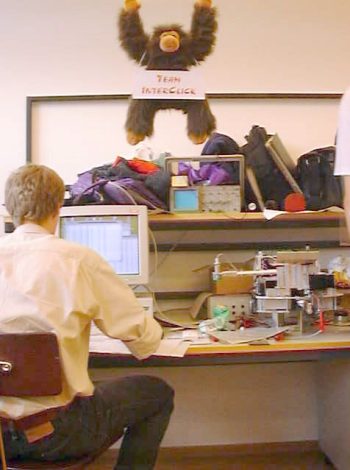
Autonomously Navigating
and Mail-Collecting Robot
Students project at the Institute of Robotics of the Swiss
Federal Institute of Technology, Zurich, Switzerland
Students: Peter Luethi, Thomas Moser, Christoph Schaer, Gabriel
Dondi, Michael Wuethrich
Assistants: Dr. S. Vestli, P. Buehler
Project duration: April 1999 - July 1999
Overview
Realization
In Action
Final Results
Acknowledgements
During the summer semester 1999, I participated with our team
consisting of 3 electronic engineers and 2 mechanic engineers in
a robot contest at the Swiss Federal Institute of Technology,
called SmartROB Contest. The task was to collect (magnetic)
envelopes in a square area (7.9 x 7.9 meters) with some walls and
gates. The map of the labyrinth was already exactly given before
the day of the contest, only the positions of the letters were
unknown.
In total 8 teams, one from the EPFL in Lausanne and 7 from the
ETH Zurich participated in the contest.
After having collected the letters, the mail had to be placed
autonomously in a specific box in a corner of the labyrinth. The
overall time budget was 4 minutes for collecting letters and
disposing them in the box.
The hardware consisted of a 300 MHz PowerPC CPU and a VME
SmartCard Interface (switches, analog-to-digital converters, PWM
engines, servos,...) built on a chassis. Our development software
equipment was XOberon, a hard real-time operating system. That's
where our team name 'Interclick' originated from: The
XOberon development environment had a special mouse click feature
using simultaneously two (or more?) mouse buttons, the so-called
interclick. Well, I'm not really convinced about this
feature...
With respect to our robot, we installed about 10 parallel
software tasks, all managed by a real-time scheduler by
specifying parameters such as period/priority, duration and/or
deadline. The software was completely object-oriented Oberon
(being also a strongly typed programming language), so it was
quite confusing in the beginning. Some basic navigation and
driving procedures were already available, but we had to adapt
and modify them for our specific needs. So guess where we spent
our weekends during that time, and at the end whole nights -
assisted by dark coffee...

Here's our work place with Windows95 and XOberon. "Tonky", the
Orang-Utan mascot of team 'Interclick', kept an eye on us,
wondering why we were spending such efforts for just a
mail-collecting robot. On the shelf resides also the digital
storage oscilloscope (DSO) to tackle the issues in the dot-matrix
LCD communication.
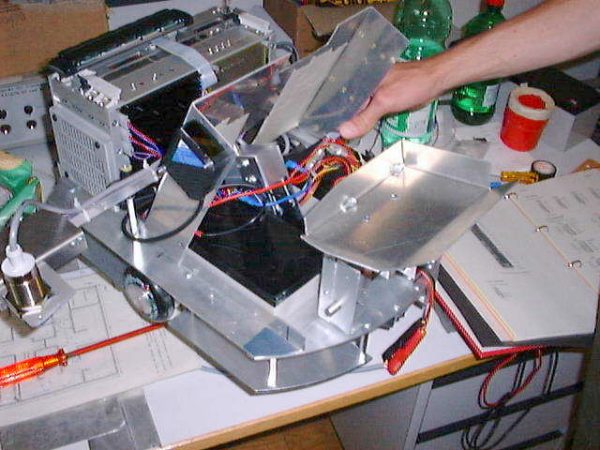
That's our robot with some large batteries inside. On the left
side resides the large cantilever arm incorporating an
electro-magnetic pick-up device and an inductive sensor at its
end. The cantilever arm is driven by a huge radio-control servo.
Not the best solution, but reliable enough for our purposes.
Behind the cantilever arm is the embedded PowerPC rack with the
dot-matrix LCD mounted on the top.
The pick-up of the letters, which had a magnetic metal plate
inside, was realized through our very strong electro-magnet: It
was so strong, that it was able to pick up twice two letters at
the same time during the competition. The letters were located
very close by each other. Our strategy in that case was to pick
up only the first one. But, when anything must go right, it will
- scarcely known as Murphy's second law ;-). Although this was
never tested before, we were lucky enough by having exactly the
right speed and timing, so that the cantilever arm was at an
adequate position above the second letter to have sufficient
electro-magnetic field force through the first letter to pick up
the second one as well. You can't see the magnet, he's behind the
inductive sensor for detecting the letters. Attached to the side
of the aluminium cover is one of the infrared distance
sensors.

Solving technical issues in limited time...
In front, our Matlab hacker Gabriel (map of waypoints and way
simulation), behind the two XOberon hackers; with red T-Shirt
Thomas, and finally me.
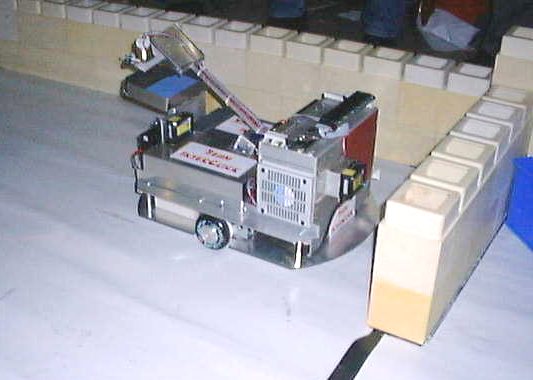
Our robot in action, already having collected some
letters.
Here you can see the two infrared distance sensors measuring the
distance to the right wall. We applied plausibility checks for
any delivered sensor data. If the deviation of the actual sensor
distance compared to historic data was too large, the data was
treated as invalid, for instance by traversing an edge.
If all data was valid, we took the arithmetic average of both
sensor distances and calculated the distance of the center of the
robot to the wall. This value was finally used for correcting the
current position and updating the position of the robot's
odometry.
To get rid of massive erroneous reflections picked up by the
sensors, we used sand paper in front of the sensors to absorb and
scatter all unwanted infrared light.
Note that everything can happen to data transmitted through
the air!
Check this possibility of errors always first, it can help you to
save a lot of time...
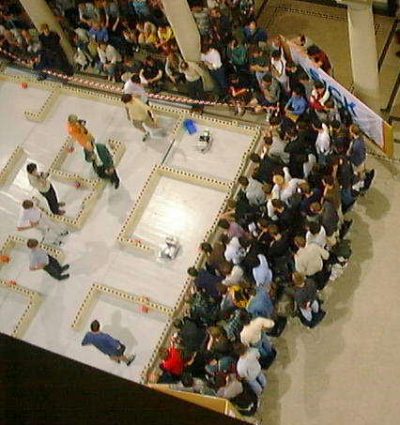
During the contest, in the main hall of the Swiss Federal
Institute of Technology in Zurich, Switzerland.
The blue box in the top right square represents one of the boxes
to dispose all mail at the end of run.
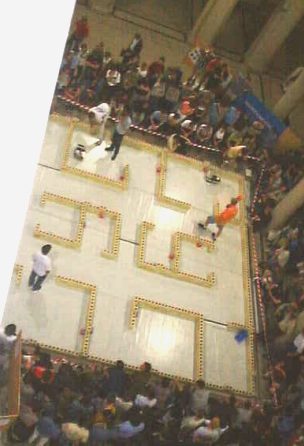
Again, at bottom right, there is one of the blue boxes, in
which the letters had to be discarded at the end of the run.
You can see our team watching our robot's contingency feature in
action, after the robot encountered a 'spatial
disorientation'.
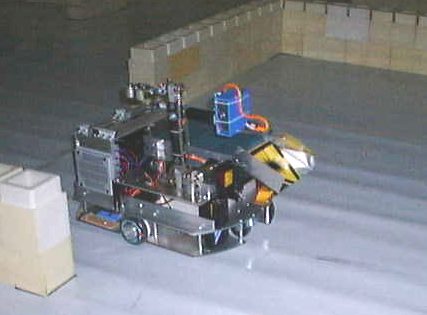
The winning robot - great work, Pele!
They employed some very expensive laser distance sensors and a
colour sensor resulting in the most expensive robot of the
contest - worth around 20'000 SFr.!
We made 3rd place, not that good we expected, but there is to say, that each of the three top classified teams could have been the winner. From the technical perspective, all of them had solved the problems of picking up the letters and navigating through the labyrinth excellent. It was finally only a lucky question of selecting the right strategy against the opponent, so that the opposing robot was driving just behind the other robot getting only empty letter boxes...
Special thanks to:
| Our team: Thomas Moser, Christoph Schaer,
Michael Wuethrich, Gabriel Dondi and me. Was great fun beside a lot of work. Thanks, guys! |
|
| S. Vestli, R. Hueppi, Roberto, B. Peyer, P. Buehler and R. Siegwart for technical support and organization. | |
| Baumer Electric, Frauenfeld, Switzerland for providing the inductive sensor. | |
| Ray Weber for providing the pictures. |
And finally congratulations to Pele and his team for making first place!
Last updated: 2010/08/31